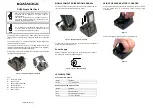
like a roof, walls, floors, ceilings, trees, etc.). Certain building materials such as glass, stucco, and metal
framework or siding, can greatly reduce the range. In order to get an accurate reading and to prolong the life
of your sensor, we recommend that you place the sensor in a sheltered area out of the sun and direct rain.
Fog and mist will not affect the sensor, but a soaking in water may.
• Sensor is wet:
If your sensor becomes soaked, bring the unit inside, remove the batteries and allow the unit to dry
overnight; then restart the station using the Proper Restart instructions. You can mount the sensor outside
under an eave of your house or any other suitable place that will keep it out of the sun and rain. Do not wrap
the sensor in plastic or seal it in a plastic bag. You may also put it in a two-sided bird feeder with a roof.
Restart: Remove batteries from all units and follow the directions in the Proper Restart section above.
• Outdoor Temperature/Humidity is Inaccurate
Batteries: Be sure you have good alkaline batteries for both the sensor and the base station. Placement: The
sensor will measure the temperature in the location where it is placed. A good location is under the eaves on
the north side of the house. You can also build a small roof or box for it if you do not have an overhang.
Please be sure it is well vented.
• Worn out:
Also, your transmitter may be defective or worn out due to age or weather condition
• Outdoor Temperature/Humidity Displays as OFL
Batteries: Be sure you have good alkaline batteries for both the sensor and the base station. If the display
shows OFL, your batteries may be weak or dead. Follow the “Proper Restart” instructions.
• Outdoor Readings are Totally Blank
If only the Outdoor Readings portions of the indoor unit are totally blank (not showing dashes or OFL), this
may a problem with the indoor unit or the batteries. Remove all batteries from all units and follow the
directions in the Proper Restart section above, using fresh batteries.
– Rain Readings
• Rain Reads 0.00:
The Rain will always read 0.00, even if no rain gauge is being used. If you are using the Rain gauge and
have had rain, but are still reading 0.00, please check the following: Debris: Is the rocker free of debris,
insect nests, leaves, etc. If it has never worked, is there tape on the rocker?
• Batteries: Are you using good alkaline batteries dated 5 years in advance?
• Mounting:
Is the rain gauge mounted level? If mounted with screws through the base, please be sure they are only snug
and not too tight.
• Distance:
It may also be that the distance between the transmitter and the receiver is too great or has too many
obstacles between the units to allow the signal to reach the transmitter.
• Rain is inaccurate
Interference: Are there sources of radio frequency or electromagnetic interference near the Base or the Rain
sensor? Ham radios, Baby monitors, Cordless Phones, etc can cause loss of signal or erratic readings.
• Mounting:
Is the rain gauge mounted level? If mounted with screws through the base, please be sure they are only snug
and not too tight.
– Wind Readings
• Wind speed inaccurate:
Is the wind speed reading 0.00 or dashes or something else? Do the cups spin freely? Are the cups clear of
insect nests leaves etc? Do all the other sensors work properly?
• Mounting:
Where is your wind sensor mounted and how high is it above the ground? In most cases, the sensor needs to
be 3-4ft above the highest point on your roof in order to clear nearby obstructions and read accurately. The
























